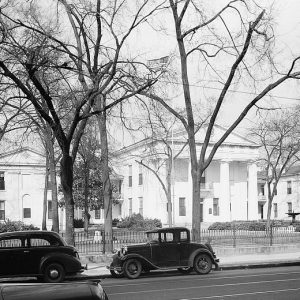calsfoundation@cals.org
Gideon Shryock (1802–1880)
Gideon Shryock is responsible for one of the finest examples of Greek Revival architecture west of the Mississippi River—the Old State House in Little Rock (Pulaski County). Shryock’s other recognizable architectural achievements include Kentucky’s Old State House and Old Morrison Hall at Transylvania College in Lexington, Kentucky. These structures still stand and still represent freedom, power, wealth, and limitless possibilities.
Gideon Shryock was born on November 15, 1802, to Mathias Shryock and Elizabeth Gaugh Shryock in Lexington, Kentucky. Mathias Shryock was once described in a newspaper article as a “practical builder” but not a professionally trained architect. The family found prosperity and popularity in Lexington. Shryock’s father held slaves as early as 1810 and served as captain of the Lexington Militia. Shryock attended Mr. Aldridge’s Lancastrian Academy for Boys and apprenticed under his father. In 1823, he moved to Philadelphia, Pennsylvania, to study architecture under William Strickland, the architect of the Tennessee State Capitol. Strickland began his apprenticeship under Benjamin Henry Latrobe working on the Bank of Pennsylvania. Latrobe was a renowned architect who won the admiration of Thomas Jefferson with his fondness for classical architecture.
Shryock returned to Lexington and opened an office in 1824. In 1827, he won a design contest to build the new Kentucky Statehouse (fire had destroyed the previous capitol). He moved his office to Frankfort, the capital, and worked as building superintendent for the next three years. In Frankfort, he married Elizabeth P. Bacon on June 30, 1829. They had eight children, four sons and four daughters. The 1830 census recorded that the Shryocks owned two slaves. Shryock wrote that the statehouse was designed after the ionic temple of Minerva Polias at the Priene (now known as Güllübahçe, Turkey). His son Charles, also an architect, wrote that Shryock “had a special fondness for the classics of the Greek and Roman schools.” Greek architecture remained a source of inspiration for his most noted public buildings. In 1831, Kentucky politician Henry Clay called on Shryock to build Morrison Hall at Transylvania College.
In 1833, John Pope, Arkansas’s territorial governor and a former Kentucky senator envisioned a new territorial capitol that “would command the admiration and respect of the passing stranger, and have moral and political influence on the whole community.” Pope engaged Shryock to draw the plans. George Weigart, Shryock’s assistant, carried to Little Rock the plans for an elegant and practical structure in the Greek Revival style and served as the construction superintendent. Other ongoing projects and possibly the death of his father prevented Shryock from ever visiting Little Rock. Pope considered the building’s ornamentation in Shryock’s design to be too costly, so Pope and Weigart modified the plans, keeping the architect’s original vision. When Arkansas became a state in 1836, legislators moved into the new statehouse while construction was still underway. Weigart died in 1834, and those who continued to labor toward the completion of the building still consulted the original architect. Superintendent Elijah A. More corresponded with Shryock concerning measurements indicated on the original plans of the building.
While the Old State House is Shryock’s most recognized structure in Arkansas, he may have designed two other buildings in Little Rock. The Historic American Buildings Survey credits him with the design of the Archibald McHenry House, also known as the Ten Mile House. However, the survey is believed to be inaccurate because the design does not suggest the need for a trained architect. Shryock is also believed to be the architect of Curran Hall, built in 1842 by Ebenezer Walters as a wedding gift for his bride, Mary Eliza Starbuck. Curran Hall (now Little Rock’s visitor information center), like the Old State House, is a Greek Revival structure.
Shryock died on June 19, 1880. He is buried at Cave Hill Cemetery in Louisville, Kentucky.
For additional information:
Blackburn, Winfrey P. Jr., and R. Scott Gill. Gideon Shryock: His Life and Architecture, 1802–1880. Louisville, KY: Butler Books, 2021.
Field, Elizabeth S. Gideon Shryock: His Life and His Work. Special Collections. Kentucky Historical Society, Frankfort, Kentucky.
Newcomb, Rexford. “Gideon Shryock—Pioneer Greek Revivalist of the Middlewest.” Register of the Kentucky Historical Society 26 (September 1928).
Roth, Leland M. A Concise History of American Architecture. New York: Harper & Row, 1979.
Adam Bergfeld
William J. Clinton Presidential Library
 Arts, Culture, and Entertainment
Arts, Culture, and Entertainment Louisiana Purchase through Early Statehood, 1803 through 1860
Louisiana Purchase through Early Statehood, 1803 through 1860 Old State House
Old State House 




Comments
No comments on this entry yet.